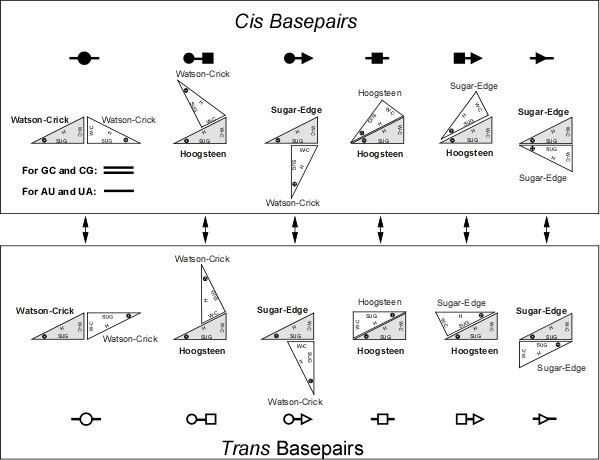see also: RNA Basepair Catalog
| No. | Bond Orientation | Interacting Edges | Symbol | Strand Orientation | Abbreviated notation |
|---|---|---|---|---|---|
| 1 | Cis | W-C/W-C | Anti-Parallel | cWW | |
| 2 | Trans | W-C/W-C | Parallel | tWW | |
| 3 | Cis | W-C/Hoogsteen | Parallel | cWH | |
| 4 | Trans | W-C/Hoogsteen | Anti-Parallel | tWH | |
| 5 | Cis | W-C/Sugar | Anti-Parallel | cWS | |
| 6 | Trans | W-C/Sugar | Parallel | tWS | |
| 7 | Cis | Hoogsteen/Hoogsteen | Anti-Parallel | cHH | |
| 8 | Trans | Hoogsteen/Hoogsteen | Parallel | tHH | |
| 9 | Cis | Hoogsteen/Sugar | Parallel | cHS | |
| 10 | Trans | Hoogsteen/Sugar | Anti-Parallel | tHS | |
| 11 | Cis | Sugar/Sugar | Anti-Parallel | cSS | |
| 12 | Trans | Sugar/Sugar | Parallel | tSS |
Notations preceded by n indicate that the interaction is “near” or close but does not meet the strict criteria for membership.

Figure A: Base edges and Base-pair geometric isomerism. (Upper left) An adenosine showing the three base edges that are available for hydrogen-bonding interactions: Watson-Crick (W-C), Hoogsteen and Sugar-edge. (Lower left) Representation of RNA base as a triangle. The position of the ribose is indicated with a circle in the corner defined by the Hoogsteen and Sugar edge. (Right) Cis and Trans base-pairing geometries, illustrated for two bases interacting with W-C edges. (Leontis & Westhof, 2001).

Figure B: Basepairs geometric families and their annotation. Upper panel: Twelve geometric basepair families resulting from all combinations of edge-to-edge interactions of two bases with cis or trans orientation of the glycosidic bonds. Circles represent W-C edges, squares Hoogsteen edges, and triangles Sugar edges. Basepair symbols are composed by combining edge symbols, with solid symbols indicating cis basepairs and open symbol, trans basepairs. Lower Left: Symbols for other pairwise interactions (Leontis et al., 2002).

The 28 possible base-pairs for A, G, U(T), and C involving at least two (cyclic) hydrogen bonds. Hydrogen and nitrogen atoms displayed as small and large filled circles, oxygen atoms as open circles, and glycosyl bonds and thick lines with R indicating ribose C1' atom. Base-pairs are boxed according to composition and symmetry, consisting of only purine, only pyrimidine, or mixed purine/pyrimidine pairs and asymmetric or symmetric base-pairs. Symmetry elements  and
and  are twofold rotation axes vertical to and within the plane of the paper. In the Watson-Crick base-pairs XIX and XX and in base-pairs VIII and XVIII, pseudosymmetry relating only glycosyl links but not individual base atoms is observed. Drawn after compilations in (33,457). [ref: W. Saenger (1984), Principles of Nucliec Acid Structure, 120-121. Springer-Verlag New York Inc., New York.]
are twofold rotation axes vertical to and within the plane of the paper. In the Watson-Crick base-pairs XIX and XX and in base-pairs VIII and XVIII, pseudosymmetry relating only glycosyl links but not individual base atoms is observed. Drawn after compilations in (33,457). [ref: W. Saenger (1984), Principles of Nucliec Acid Structure, 120-121. Springer-Verlag New York Inc., New York.]

| No. | Interacting Edge | Symbol | Notation |
|---|---|---|---|
| 1 | Sugar | 1BPh | |
| 2 | Sugar or W-C | 2BPh | |
| 3 | W-C | 3BPh | |
| 4 | W-C | 4BPh | |
| 5 | W-C | 5BPh | |
| 6 | W-C | 6BPh | |
| 7 | Hoogsteen | 7BPh | |
| 8 | Hoogsteen | 8BPh | |
| 9 | Hoogsteen | 9BPh | |
| 10 | Hoogsteen | 0BPh |
Notations preceded by n indicate that the interaction is “near” or close but does not meet the strict criteria for membership.
Proposed nomenclature for BPh interactions and superpositions of idealized BPh interactions observed
in RNA 3D crystal structures for each base. H-bonds are indicated with dashed lines. BPh categories
are numbered 0 to 9, starting at the H6 (pyrimidine) or H8 (purine) base positions. BPh interactions
that involve equivalent functional groups on different bases are grouped together,
e.g. [0BPh (A,C,G,U) 5BPh (G,U)], [6BPh (A,C), 7BPh (A,C) and 9BPh (C,U)].
Zirbel C L et al. Nucl. Acids Res. 2009;37:4898-4918
s35 is a stacking interaction in which the first base uses its 3 face, and the second base uses its 5 face. Similarly, in s53, s33, s55, s stands for stacking and the two number stand for the face used by the first base and second base in the interaction respectively.
Source : WebFR3D Help